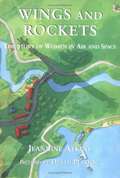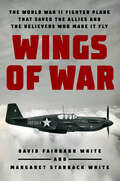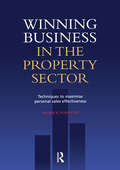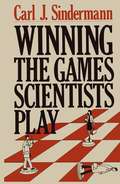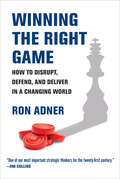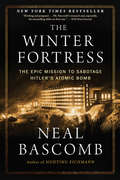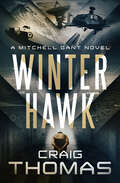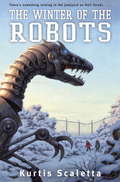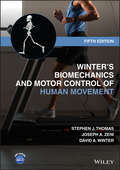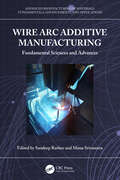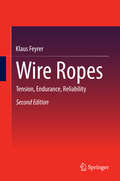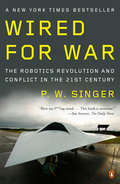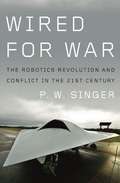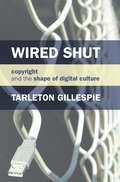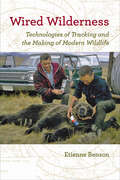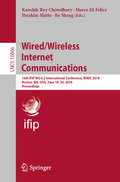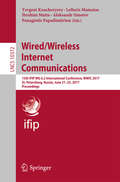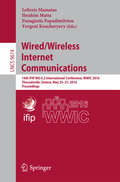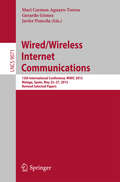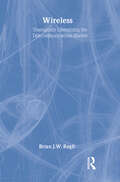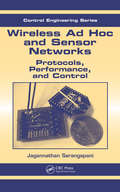- Table View
- List View
Wings and Rockets: The Story of Women in Air and Space
by Jeannine AtkinsCelebrating the hundredth anniversary of powered flight From Katharine Wright, sister of the Wright brothers, to Eileen Collins, the first woman commander of a spacecraft, scores of women have played critical roles in our country's history of aviation. Wilbur and Orville Wright, who pioneered powered flight in 1903, knew how much they owed to Katharine. "When the world speaks of the Wrights," said Orville, "they should not forget our sister. " Although Katharine Wright was among the first women to ride in an airplane, Blanche Stuart Scott was the first to sit at the controls. To achieve her dream, Blanche overcame sexism and other obstacles. The same can be said of every woman whose piloting career is highlighted here - Bessie Coleman, Amelia Earhart, Jackie Cochran, Ann Baumgartner Carl, Jerrie Cobb, Shannon Wells Lucid, and others. Their stories are sure to fire the imaginations of readers and encourage them to "follow their hearts into the sky" - or anywhere at all. This beautifully articulated history of American women who broke barriers to achieve an especially satisfying success is enhanced by clever, captivating halftone illustrations.
Wings of War: The World War II Fighter Plane that Saved the Allies and the Believers Who Made It Fly
by David Fairbank White Margaret Stanback WhiteThe incredible, untold story behind the rise of the P-51 Mustang, the World War II fighter plane that destroyed the Luftwaffe and made D-Day possible&“[A] fascinating book about passion and innovation.&”—Walter Isaacson • &“An essential book for those who appreciate tales of military bravery, and also for all seeking understanding of decision-making under pressure. A major contribution.&”—E. J. Dionne, Jr.When the P-51 Mustang began tearing across European skies in early 1944, the Allies had been losing the air war for years. Staggering numbers of bomber crews, both British and American, had been shot down and killed thanks to the Luftwaffe&’s superior fighter force. Not only did the air war appear grim, but any landing of troops in France was impossible while German fighters hunted overhead. But behind the scenes, a team of visionaries had begun to design a bold new type of airplane, one that could outrun and outmaneuver Germany&’s best. Wings of War is the incredible true story of the P-51 Mustang fighter and the unlikely crew of designers, engineers, test pilots, and army officers who brought it from the drafting table to the skies over World War II. This is hardly a straightforward tale of building an airplane—for years, the team was stymied by corruption within the defense industry and stonewalled by the Army Air Forces, who failed to understand the Mustang&’s potential. But when squadrons of Mustangs were finally unleashed over Hitler&’s empire, the Luftwaffe was decimated within months, clearing the skies for D-Day. A compelling, character-focused narrative replete with innovation, determination, and bravery, Wings of War is the never-before-told story of the airplane that truly changed the course of World War II.
Winning Business in the Property Sector
by Patrick ForsythThis book reviews a variety of aspects of the specific task of selling successfully as it applies to those working in the property sector. It provides guidelines and approaches that will enable one to sharpen their sales skills and maximise the results they produce.
Winning Online Instruction: A Q&A for Higher Education Faculty
by Daniel Hillman Robert Schudy Anatoly TemkinWinning Online Instruction provides concise, pragmatic solutions to common challenges and demands that higher education faculty face in teaching online. This book’s unique question-and-answer format allows readers to easily identify the issues important to them, spanning online formats and teaching methods, course development and technology woes, student motivation and engagement, academic integrity and fair grading, and more. Written for instructors who have little to no experience designing and teaching online courses or who are teaching online courses developed in a hurry, this is an approachable, efficient guide to the real problems of everyday distance education.
Winning the Games Scientists Play
by Carl J. SindermannIn this inspiring book of personal insight and sound advice, veteran scientist Carl J. Sindermann gives an insider's look at the competitive world of science and reveals the best strategies for attaining prominence and success.
Winning the Right Game: How to Disrupt, Defend, and Deliver in a Changing World (Management on the Cutting Edge)
by Ron AdnerHow to succeed in an era of ecosystem-based disruption: strategies and tools for offense, defense, timing, and leadership in a changing competitive landscape.The basis of competition is changing. Are you prepared? Rivalry is shifting from well-defined industries to broader ecosystems: automobiles to mobility platforms; banking to fintech; television broadcasting to video streaming. Your competitors are coming from new directions and pursuing different goals from those of your familiar rivals. In this world, succeeding with the old rules can mean losing the new game. Winning the Right Game introduces the concepts, tools, and frameworks necessary to confront the threat of ecosystem disruption and to develop the strategies that will let your organization play ecosystem offense. To succeed in this world, you need to change your perspective on competition, growth, and leadership. In this book, strategy expert Ron Adner offers a new way of thinking, illustrating breakthrough ideas with compelling cases. How did a strategy of ecosystem defense save Wayfair and Spotify from being crushed by giants Amazon and Apple? How did Oprah Winfrey redraw industry boundaries to transition from television host to multimedia mogul? How did a shift to an alignment mindset enable Microsoft's cloud-based revival? Each was rooted in a new approach to competitors, partners, and timing that you can apply to your own organization. For today's leaders the difference between success and failure is no longer simply winning, but rather being sure that you are winning the right game.
The Winter Fortress: The Epic Mission to Sabotage Hitler's Atomic Bomb
by Neal BascombFrom the internationally acclaimed, best-selling author of Hunting Eichmann and The Perfect Mile, an epic adventure and spy story about the greatest act of sabotage in all of World War II. It's 1942 and the Nazis are racing to be the first to build a weapon unlike any known before. They have the physicists, they have the uranium, and now all their plans depend on amassing a single ingredient: heavy water, which is produced in Norway's Vemork, the lone plant in all the world that makes this rare substance. Under threat of death, Vemork's engineers push production into overdrive. For the Allies, the plant must be destroyed. But how would they reach the castle fortress set on a precipitous gorge in one of the coldest, most inhospitable places on Earth? Based on a trove of top secret documents and never-before-seen diaries and letters of the saboteurs, The Winter Fortress is an arresting chronicle of a brilliant scientist, a band of spies on skies, perilous survival in the wild, sacrifice for one's country, Gestapo manhunts, soul-crushing setbacks, and a last-minute operation that would end any chance Hitler could obtain the atomic bomb--and alter the course of the war.
Winter Hawk (The Mitchell Gant Series)
by Craig ThomasNew York Times Bestseller: &“A thrill ride . . . The technical details and intricate depiction of Soviet life fascinate.&” —Kirkus Reviews (starred review) American pilot Mitchell Gant barely escaped the USSR alive after stealing its cutting-edge stealth fighter. Nevertheless, he&’s going back again—this time, to rescue an American agent with evidence of a looming threat. A group of highly placed, power-hungry Soviets, who want to undermine any hope of a treaty between the superpowers, has plans to put a laser battle station into orbit and destroy America&’s space shuttle. To stop them, Gant will first have to maneuver across a thousand miles of airspace—in a helicopter. Once he arrives, he will find himself teaming up with an unexpected ally . . . &“With this third Mitchell Gant adventure Thomas firmly establishes himself in the forefront of today&’s adventure/thriller writers.&” —Publishers Weekly
The Winter of the Robots
by Kurtis ScalettaSeven feet of snow, four science-fair nerds, one creepy junkyard. Get ready for the ultimate robot battle.Jim is tired of being the sidekick to his scientific genius, robot-obsessed, best friend Oliver. So this winter, when it comes time to choose partners for the science fair, Jim dumps Oliver and teams up with a girl instead. Rocky has spotted wild otters down by the river, and her idea is to study them. But what they discover is bigger--and much more menacing--than fuzzy otters: a hidden junkyard on abandoned Half Street. And as desolate as it may seem, there's something living in the junkyard. Something that won't be contained for long by the rusty fences and mounds of snow. Can Jim and Rocky--along with Oliver and his new science-fair partner--put aside their rivalry and unite their robot-building skills? Whatever is lurking on Half Street is about to meet its match.From the Hardcover edition.
Winter's Biomechanics and Motor Control of Human Movement
by Stephen J. Thomas Joseph A. Zeni David A. WinterAn In-Depth Resource for Understanding the Foundational Concepts and Clinical Applications in the Field of Biomechanics Winter’s Biomechanics and Motor Control of Human Movement is highly suitable as a textbook for today’s biomechanics students who may come from many diverse academic programs and professional sectors. The work covers foundational theoretical and mathematical concepts in biomechanics, as well as up-to-date data collection, interpretation, and storage techniques. It also highlights the contemporary clinical applications of biomechanical research. New case studies related to cerebral palsy, patellar femoral pain syndrome, knee osteoarthritis, and ulnar collateral ligament reconstruction are also included. The work appeals to a broad audience within the field of biomechanics, an interdisciplinary field with applications in mechanical engineering, medicine, physical therapy, sports and exercise, and product development. Authors at leading universities guide the reader through the latest advancements in the field while also imparting critical foundational knowledge to allow for subject matter mastery and more precise practical application. Concepts covered in the book include: Biomechanical signal processing, anthropometry, kinematics and kinetics, muscle mechanics, and kinesiological electromyography Forward simulations and muscle-actuated simulations, static and dynamic balance, and the role of the central nervous system in biomechanics Movement sequencing and the kinetic chain concept, electromagnetic systems, inertial sensors, clinical measures of kinematics, and the advantages and disadvantages of different types of force plates Markerset design and event detection for gait and athletic motions like jumping, landing, and pitching Guidance on setting up a motion lab and access to online Excel spreadsheets with kinematic and kinetic marker data By providing a combination of theoretical and practical knowledge, Winter’s Biomechanics and Motor Control of Human Movement will appeal to biomedical engineers working in the field of biomechanics and allied professionals in the medical, rehabilitation, and sports industries. Its comprehensive overall insight into the field of biomechanics also makes the work a highly useful resource for students and teachers of biomechanics at all levels of experience and expertise.
Wire Arc Additive Manufacturing: Fundamental Sciences and Advances (Advanced Manufacturing of Materials)
by Sandeep Rathee Manu SrivastavaThis book presents wire arc additive manufacturing (WAAM), its variants, processing steps, and the mechanical and microstructural aspects of developed components, along with a logical sequence that provides a ready reference. Wire Arc Additive Manufacturing: Fundamental Sciences and Advances introduces the timeline and history of WAAM. It offers a critical review of WAAM, its variants, processing steps, and the mechanical and microstructural aspects of developed components. The book showcases the methods and practices that need to be followed to synchronise WAAM with other conventional metal additive manufacturing, as well as other conventional techniques. The process steps, equipment, and the different materials used are discussed in detail, along with the various process parameters and their optimisation to counter the challenges and defects. Applications, trends, and case studies are also included in the book. This book, aimed at providing a concrete reference for researchers, academics, and professionals, allows for a thorough understanding of the different concepts and intricacies of WAAM.
Wire Ropes
by Klaus FeyrerThe main goal of this book is to present the methods used to calculate the most important parameters for ropes, and to explain how they are applied on the basis of numerous sample calculations. The book, based on the most important chapters of the German book DRAHTSEILE, has been updated to reflect the latest developments, with the new edition especially focusing on computational methods for wire ropes. Many new calculations and examples have also been added to facilitate the dimensioning and calculation of mechanical characteristics of wire ropes. This book offers a valuable resource for all those working with wire ropes, including construction engineers, operators and supervisors of machines and installations involving wire ropes.
Wired for War
by P. W. SingerIn Wired for War, P. W. Singer explores the greatest revolution in military affairs since the atom bomb: the dawn of robotic warfare. We are on the cusp of a massive shift in military technology that threatens to make real the stuff of I, Robot and The Terminator. Blending historical evidence with interviews of an amazing cast of characters, Singer shows how technology is changing not just how wars are fought, but also the politics, economics, laws, and the ethics that surround war itself. Travelling from the battlefields of Iraq and Afghanistan to modern-day "skunk works" in the midst of suburbia, Wired for War will tantalise a wide readership, from military buffs to policy wonks to gearheads.
Wired for War: The Robotics Revolution And Conflict In The Twenty-First Century
by P. W. SingerA military expert reveals how science fiction is fast becoming reality on the battlefield, changing not just how wars are fought, but also the politics, economics, laws, and ethics that surround war itself P. W. Singer's previous two books foretold the rise of private military contractors and the advent of child soldiers- predictions that proved all too accurate. Now, he explores the greatest revolution in military affairs since the atom bomb-the advent of robotic warfare.We are just beginning to see a massive shift in military technology that threatens to make the stuff of I,Robot and the Terminator all too real. More than 7,000 robotic systems are now in Iraq. Pilots in Nevada are remotely killing terrorists in Afghanistan. Scientists are debating just how smart-and how lethal-to make their current robotic prototypes. And many of the most renowned science fiction authors are secretly consulting for the Pentagon on the next generation.Blending historic evidence with interviews from the field, Singer vividly shows that as these technologies multiply, they will have profound effects on the front lines as well as on the politics back home. Moving humans off the battlefield makes wars easier to start, but more complex to fight. Replacing men with machines may save some lives, but will lower the morale and psychological barriers to killing. The 'warrior ethos,' which has long defined soldiers' identity, will erode, as will the laws of war that have governed military conflict for generations.Paradoxically, these new technologies will also bring war to our doorstep. As other nations and even terrorist organizations start to build or buy their own robotic weapons, the robot revolution could undermine America's military preeminence.
Wired for War
by P. W. Singer"riveting and comprehensive, encompassing every aspect of the rise of military robotics." --Financial Times In Wired for War, P. W. Singer explores the greatest revolution in military affairs since the atom bomb: the dawn of robotic warfare. We are on the cusp of a massive shift in military technology that threatens to make real the stuff of I, Robot and The Terminator. Blending historical evidence with interviews of an amazing cast of characters, Singer shows how technology is changing not just how wars are fought, but also the politics, economics, laws, and the ethics that surround war itself. Traveling from the battlefields of Iraq and Afghanistan to modern-day "skunk works" in the midst of suburbia, Wired for War will tantalize a wide readership, from military buffs to policy wonks to gearheads.
Wired Shut: Copyright and the Shape of Digital Culture (The\mit Press Ser.)
by Tarleton GillespieHow the shift toward "technical copy protection" in the battle over digital copyright depends on changing political and commercial alignments that are profoundly shaping the future of cultural expression in a digital age.While the public and the media have been distracted by the story of Napster, warnings about the evils of "piracy," and lawsuits by the recording and film industries, the enforcement of copyright law in the digital world has quietly shifted from regulating copying to regulating the design of technology. Lawmakers and commercial interests are pursuing what might be called a technical fix: instead of specifying what can and cannot be done legally with a copyrighted work, this new approach calls for the strategic use of encryption technologies to build standards of copyright directly into digital devices so that some uses are possible and others rendered impossible. In Wired Shut, Tarleton Gillespie examines this shift to "technical copy protection" and its profound political, economic, and cultural implications.Gillespie reveals that the real story is not the technological controls themselves but the political, economic, and cultural arrangements being put in place to make them work. He shows that this approach to digital copyright depends on new kinds of alliances among content and technology industries, legislators, regulators, and the courts, and is changing the relationship between law and technology in the process. The film and music industries, he claims, are deploying copyright in order to funnel digital culture into increasingly commercial patterns that threaten to undermine the democratic potential of a network society. In this broad context, Gillespie examines three recent controversies over digital copyright: the failed effort to develop copy protection for portable music players with the Strategic Digital Music Initiative (SDMI); the encryption system used in DVDs, and the film industry's legal response to the tools that challenged them; and the attempt by the FCC to mandate the "broadcast flag" copy protection system for digital television. In each, he argues that whether or not such technical constraints ever succeed, the political alignments required will profoundly shape the future of cultural expression in a digital age.
Wired Wilderness: Technologies of Tracking and the Making of Modern Wildlife (Animals, History, Culture)
by Etienne BensonAmerican wildlife biologists first began fitting animals with radio transmitters in the 1950s. By the 1980s the practice had proven so useful to scientists and nonscientists alike that it became global. Wired Wilderness is the first book-length study of the origin, evolution, use, and impact of these now-commonplace tracking technologies.Combining approaches from environmental history, the history of science and technology, animal studies, and the cultural and political history of the United States, Etienne Benson traces the radio tracking of wild animals across a wide range of institutions, regions, and species and in a variety of contexts. He explains how hunters, animal-rights activists, and other conservation-minded groups gradually turned tagging from a tool for control into a conduit for connection with wildlife. Drawing on extensive archival research, interviews with wildlife biologists and engineers, and in-depth case studies of specific conservation issues—such as the management of deer, grouse, and other game animals in the upper Midwest and the conservation of tigers and rhinoceroses in Nepal—Benson illuminates telemetry's context-dependent uses and meanings as well as commonalities among tagging practices.Wired Wilderness traces the evolution of the modern wildlife biologist’s field practices and shows how the intense interest of nonscientists at once constrained and benefited the field. Scholars of and researchers involved in wildlife management will find this history both fascinating and revealing.
Wired/Wireless Internet Communications: Second International Conference, Wwic 2004 Frankfurt (oder), Germany, February 2004, Proceedings (Lecture Notes in Computer Science #Vol. 2957)
by Kaushik Roy Chowdhury Marco Di Felice Ibrahim Matta Bo ShengThis book constitutes the proceedings of the 16th IFIP International Conference on Wired/Wireless Internet Communications, WWIC 2018, held in Boston, MA, USA, in June 2018. The 26 regular papers presented in this volume were carefully reviewed and selected from 42 submissions. They were organized in topical sections named: IoT and sensor networks; learning-based networking; network deployment; network security; aerial networks; and vehicular and content delivery networks.
Wired/Wireless Internet Communications
by Yevgeni Koucheryavy Lefteris Mamatas Ibrahim Matta Aleksandr Ometov Panagiotis PapadimitriouWelcome to the 3rd International Conference on Wired/Wireless Internet C- munications (WWIC). After a successful start in Las Vegas and a selective c- ference in Germany, this year s WWIC demonstrated the event s maturity. The conference was supported by several sponsors, both international and local, and became the o?cial venue for COST Action 290. That said, WWIC has now been established as a top-quality conference to promote research on the convergence of wired and wireless networks. This year we received 117 submissions, which allowed us to organize an - citing program with excellent research results, but required more e?ort from the 54 members of the international Program Committee and the 51 additional reviewers. For each of the 117 submitted papers we asked three independent - viewers to provide their evaluation. Based on an online ballot phase and a TPC meeting organized in Colmar (France), we selected 34 high-quality papers for presentation at the conference. Thus, the acceptance rate for this year was 29%. "
Wired/Wireless Internet Communications
by Lefteris Mamatas Ibrahim Matta Panagiotis Papadimitriou Yevgeni KoucheryavyThis book constitutes the refereed proceedings of the 14th IFIP WG 6. 2 International Conference on Wired/Wireless Internet Communications, WWIC 2016, held in Thessaloniki, Greece, in May 2016. The 27 papers presented in this volume were carefully reviewed and selected from 54 submissions. The topics addressed are: wireless technologies and systems, middleboxes and addressing, energy efficiency, network applications and tools, network protocols, network modeling, wireless sensor networks, and resource management and optimization.
Wired/Wireless Internet Communications
by Mari Carmen Aguayo-Torres Gerardo Gómez Javier PoncelaThis book constitutes the thoroughly refereed post-conference proceedings of the 13th International Conference on Wired/Wireless Internet Communications, WWIC 2015, held in Malaga, Spain, in May 2015. The 31 papers presented in this volume were carefully reviewed and selected from 43 submissions. They focus on the efficient integration of new network approaches with the traditional wired infrastructure. The topics addressed are: design and evaluation of protocols, dynamics of the integration, performance tradeoffs, and the need for new performance metrics and cross-layer interactions.
Wired Wonder Woof (AstroKids #3)
by Robert ElmerWELCOME TO 2175! Meet the Astrokids --Mir, Buzz, Miko, DeeBee, and Tag --five friends learning biblical truth through out-of-this-world adventures aboard space station CLEO-7. "Nyet, my jokes aren't always a hit. Still, who knew they'd land me in so much trouble? Especially when I was trying to be serious!" "Please understand, I felt guilty about spying on my friends. It all started with a Galaxian trader--and our dog, Zero-G. Sure, Zero-G can talk, thanks to the Mind-2-Voice collar DeeBee made him. But why was the Galaxian so interested in our space mutt? This guy had to be hiding something. But would the other AstroKids believe me?"
Wireless: Strategically Liberalizing the Telecommunications Market (Lea Telecommunications Ser.)
by Brian J.W. RegliThe revolution of wireless communications has only just begun to transform the telecommunications industry worldwide. This book offers insight into the possible options for corporate strategists and government policymakers as they look to harness the expansion of wireless communications to meet the goals of sustainable telecommunications development. Using a multidisciplinary approach which combines policy research, legal analysis, business economics, and models of sustainability from the environmental sciences, the book compares the development of wireless communications in four countries: the United States, the United Kingdom, Russia, and Brazil. The comparative analysis points to common themes and opportunities, including: * breaking down the barriers between wireless and wireline access by changing the regulatory design which constrains service providers; * targeting the development potential of wireless access through the utilization of new technologies and service models; and * using wireless access as the basis for full facilities-based competition in both developing and developed world markets. No other book today offers this broad a context for a discussion of wireless communications and its potential impact on the evolution of the telecommunications industry.
Wireless Ad Hoc and Sensor Networks: Protocols, Performance, and Control (Automation and Control Engineering #25)
by Jagannathan SarangapaniWith modern communication networks continuing to grow in traffic, size, complexity, and variety, control systems are critical to ensure quality and effectively manage network traffic. Providing a thorough and authoritative introduction, Wireless Ad hoc and Sensor Networks: Protocols, Performance, and Control examines the theory, architectures, and technologies needed to implement quality of service (QoS) in a wide variety of communication networks. Based on years of research and practical experience, this book examines the technical concepts underlying the design, implementation, research, and invention of both wired and wireless networks. The author builds a strong understanding of general concepts and common principles while also exploring issues that are specific to wired, cellular, wireless ad hoc, and sensor networks. Beginning with an overview of networks and QoS control, he systematically explores timely areas such as Lyapunov analysis, congestion control of high-speed networks, admission control based on hybrid system theory, distributed power control of various network types, link state routing using QoS parameters, and predictive congestion control. The book also provides a framework for implementing QoS control using mote hardware. Providing a deeply detailed yet conveniently practical guide to QoS implementation, Wireless Ad hoc and Sensor Networks: Protocols, Performance, and Control is the perfect introduction for anyone new to the field as well as an ideal reference guide for seasoned network practitioners.
Wireless AI: Wireless Sensing, Positioning, IoT, and Communications
by K. J. Liu Beibei WangWith this groundbreaking text, discover how wireless artificial intelligence (AI) can be used to determine position at centimeter level, sense motion and vital signs, and identify events and people. Using a highly innovative approach that employs existing wireless equipment and signal processing techniques to turn multipaths into virtual antennas, combined with the physical principle of time reversal and machine learning, it covers fundamental theory, extensive experimental results, and real practical use cases developed for products and applications. Topics explored include indoor positioning and tracking, wireless sensing and analytics, wireless power transfer and energy efficiency, 5G and next-generation communications, and the connection of large numbers of heterogeneous IoT devices of various bandwidths and capabilities. Demo videos accompanying the book online enhance understanding of these topics. Providing a unified framework for wireless AI, this is an excellent text for graduate students, researchers, and professionals working in wireless sensing, positioning, IoT, machine learning, signal processing and wireless communications.
